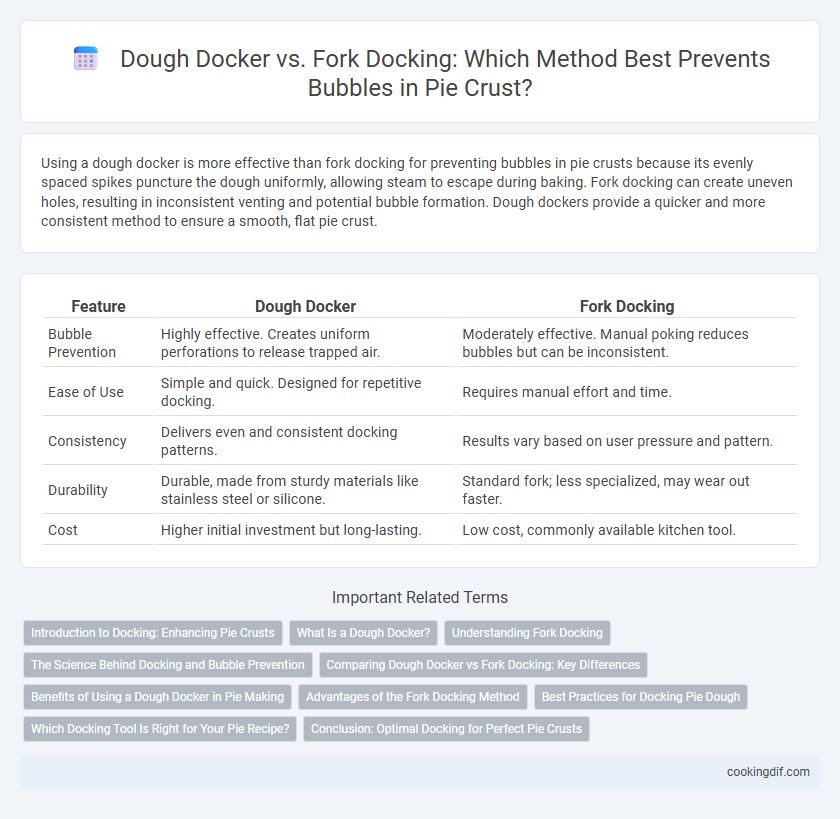Using a dough docker is more effective than fork docking for preventing bubbles in pie crusts because its evenly spaced spikes puncture the dough uniformly, allowing steam to escape during baking. Fork docking can create uneven holes, resulting in inconsistent venting and potential bubble formation. Dough dockers provide a quicker and more consistent method to ensure a smooth, flat pie crust.
Table of Comparison
| Feature | Dough Docker | Fork Docking |
|---|---|---|
| Bubble Prevention | Highly effective. Creates uniform perforations to release trapped air. | Moderately effective. Manual poking reduces bubbles but can be inconsistent. |
| Ease of Use | Simple and quick. Designed for repetitive docking. | Requires manual effort and time. |
| Consistency | Delivers even and consistent docking patterns. | Results vary based on user pressure and pattern. |
| Durability | Durable, made from sturdy materials like stainless steel or silicone. | Standard fork; less specialized, may wear out faster. |
| Cost | Higher initial investment but long-lasting. | Low cost, commonly available kitchen tool. |
Introduction to Docking: Enhancing Pie Crusts
Dough docking involves using a specialized tool called a dough docker to create uniform holes in the pie crust, effectively preventing large bubbles by allowing steam to escape evenly during baking. Fork docking serves a similar purpose but tends to produce less consistent holes, potentially resulting in uneven bubbling and texture. Employing a dough docker enhances the structural integrity and appearance of pie crusts, making it a preferred method for professional and home bakers aiming for flawless results.
What Is a Dough Docker?
A dough docker is a specialized tool designed with multiple small spikes or pins used to pierce the dough evenly, preventing air bubbles from forming during baking. Unlike fork docking, which creates irregular holes, a dough docker ensures consistent docking that maintains the dough's structural integrity and promotes even cooking. This tool is especially effective for pie crusts, pizzas, and flatbreads to avoid unwanted puffing and blistering.
Understanding Fork Docking
Fork docking creates small perforations in pie dough that allow steam to escape evenly during baking, reducing the risk of large bubbles forming. Unlike dough docking tools, which press multiple small holes quickly, fork docking offers a controlled method by manually piercing the dough, enhancing crust texture and preventing overbaking. This technique is essential for achieving a crisp, flat crust especially in pies with wet fillings that produce ample steam.
The Science Behind Docking and Bubble Prevention
Dough docking creates uniform perforations that release trapped gas during baking, preventing large bubbles and ensuring an even crust texture. Fork docking produces less consistent holes, resulting in uneven gas escape and potential bubbly spots. Scientific studies show that controlled docking patterns optimize gas release, improving pie crust stability and appearance.
Comparing Dough Docker vs Fork Docking: Key Differences
Dough docker and fork docking are both techniques used to prevent bubbles in pie crusts by creating small holes that allow steam to escape during baking. Dough dockers feature rows of spikes that puncture the dough evenly and efficiently, providing uniform steam release and reducing the risk of crust puffing. Fork docking, on the other hand, involves manually pricking the dough with a fork, which may result in less consistent hole distribution and increased chances of uneven bubbling.
Benefits of Using a Dough Docker in Pie Making
Using a dough docker in pie making evenly perforates the dough, preventing large air bubbles and ensuring a uniform crust thickness. This tool minimizes the risk of over-puffed areas, resulting in a consistent bake and an aesthetically pleasing pie surface. Compared to fork docking, a dough docker provides more precise and efficient venting, enhancing texture and reducing baking defects.
Advantages of the Fork Docking Method
Fork docking creates more uniform and smaller perforations in the pie dough, allowing steam to escape evenly and reducing the risk of large air bubbles forming during baking. This method offers greater control over the dough surface compared to traditional dough dockers, leading to a more consistent texture and preventing uneven rising. The fork docking technique is especially advantageous for delicate or thin crusts, ensuring a smooth, well-baked pie crust without undesirable puffing.
Best Practices for Docking Pie Dough
Dough dockers and fork docking are essential techniques to prevent bubbles when baking pie crusts, with dockers providing uniform perforations that ensure even steam release. Best practices recommend using a dough docker for consistent results, especially when working with tender or flaky pie dough, as it minimizes the risk of overworking the crust. Fork docking remains a viable alternative for home bakers, but applying even pressure and maintaining consistent spacing between pricks is crucial to avoid uneven bubbling.
Which Docking Tool Is Right for Your Pie Recipe?
Dough dockers create uniform perforations that evenly release steam, preventing large air bubbles and ensuring a flat, crisp pie crust, ideal for delicate fruit or custard fillings. Fork docking produces irregular holes that may result in uneven steam escape, potentially causing uneven bubbling but offering a more rustic crust appearance. Choose a dough docker for consistency and precision in professional or high-volume baking, while fork docking suits home bakers seeking simplicity and traditional texture.
Conclusion: Optimal Docking for Perfect Pie Crusts
Dough docking with a specialized docker creates uniform perforations that effectively prevent bubbles by allowing steam to escape evenly during baking, resulting in a crisp, flat pie crust. Fork docking, while accessible, produces irregular holes that may not release steam as efficiently, potentially causing uneven bubbles. For achieving consistently perfect pie crusts, dough dockers offer optimal docking precision and reliable bubble prevention.
Dough docker vs fork docking for preventing bubbles Infographic

 cookingdif.com
cookingdif.com